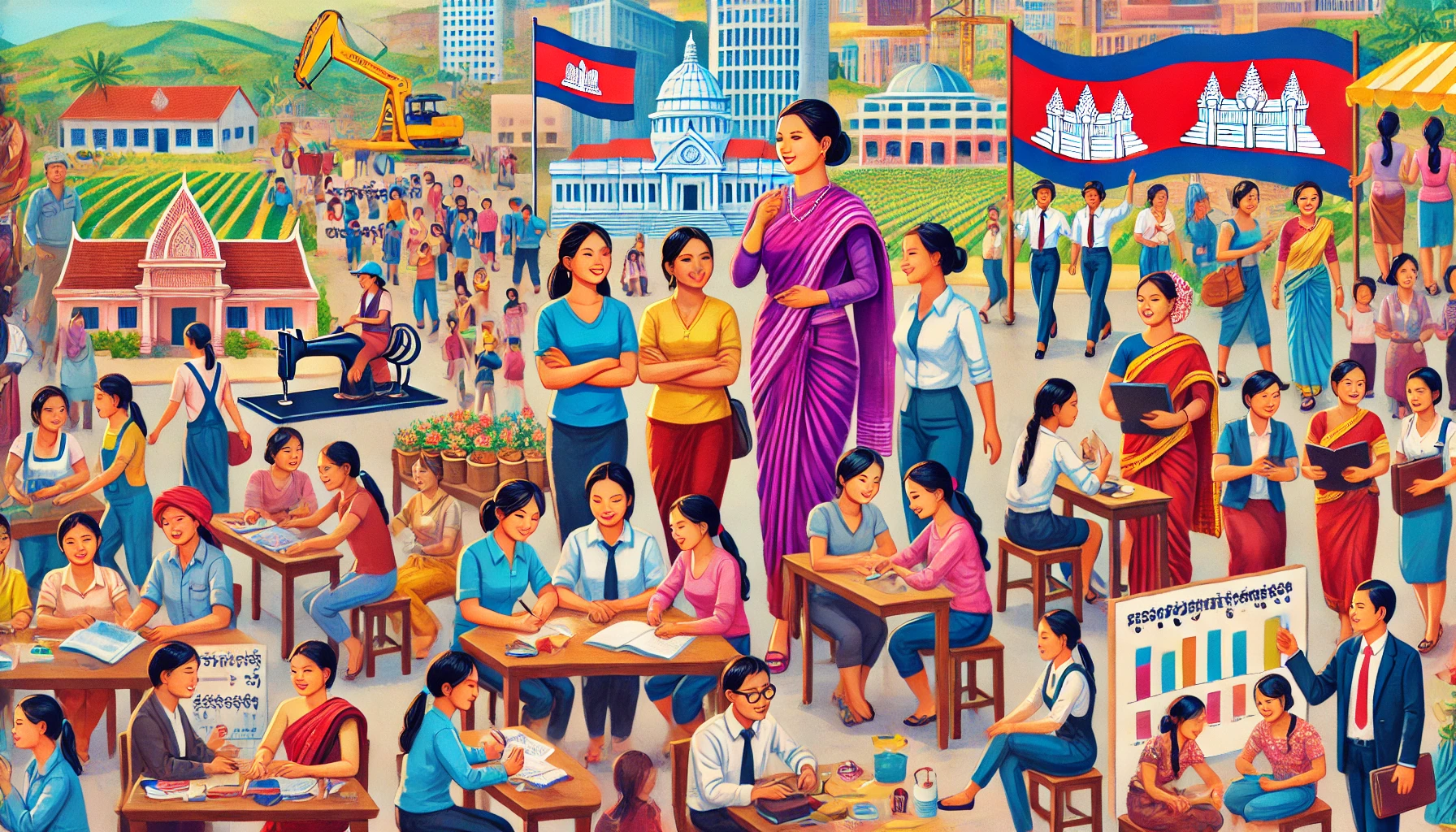Tackling Gender Disparities in Cambodia: A Comprehensive Action Plan for the Next Five Years
The World Bank’s Cambodia Country Gender Action Plan (FY25–FY29) outlines efforts to address gender disparities by improving women’s health, education, economic participation, and leadership, while tackling gender-based violence. The plan aims to ensure sustainable gender equality in line with Cambodia’s broader development goals.

The World Bank’s Cambodia Country Gender Action Plan (FY25–FY29), developed by the World Bank Group, highlights both the progress and ongoing challenges related to gender equality in Cambodia. While the country has seen improvements, particularly in education for girls and women, significant disparities remain in women’s economic participation, leadership, and vulnerability to gender-based violence. Cambodia’s Global Gender Gap Index has gradually increased since 2007, and the country ranks 92nd out of 146 nations in the 2023 World Economic Forum’s Global Gender Gap report. Despite these gains, Cambodia struggles to close the gender gap in key areas like political empowerment and formal employment. The lack of robust legal protections and supportive frameworks exacerbates the challenges women face in these areas, indicating the need for more comprehensive policies to ensure gender parity across all sectors of society.
Improving Maternal and Child Health Amid Persistent Challenges
One of the key areas where Cambodia has seen progress is in human capital development, particularly maternal health. The maternal mortality ratio (MMR) has significantly declined over the last decade due to increased access to skilled delivery and antenatal care. Nearly all births are now attended by skilled health workers, contributing to a drop in maternal deaths from 606 per 100,000 live births in 2000 to 218 in 2020. However, maternal mortality rates in Cambodia still exceed the East Asia and Pacific regional average. Child health has also improved, with under-five mortality rates more than halving between 2014 and 2021. However, stunting remains a critical issue, particularly for boys in rural areas, affecting children’s cognitive development and future productivity. Cambodia continues to face a high prevalence of child marriage, especially in remote areas, where traditional gender roles push families to marry off daughters early, limiting their educational and economic opportunities.
Gender-Based Violence and Inadequate Legal Protections
Gender-based violence (GBV), particularly intimate partner violence (IPV), remains a pervasive issue in Cambodia, with 21 percent of women experiencing some form of emotional, physical, or sexual violence from a partner. The COVID-19 pandemic likely exacerbated these issues, as domestic violence rates increased during lockdowns. Women in rural areas and those with disabilities are particularly vulnerable to such violence. Despite the passage of the Prevention of Domestic Violence and Protection of Victims Act in 2005, gaps in the legislation leave many women unprotected, particularly those in non-marital relationships. Cultural norms and a lack of access to formal justice mechanisms mean that many women rely on community mediation rather than pursuing legal action. Furthermore, human trafficking remains a concern, particularly for women and girls, although reliable data on the issue are scarce.
Progress in Education, But Economic Pressures Force Boys to Drop Out
Education is one area where Cambodia has made significant strides, achieving near gender parity in primary school enrollment. However, boys are less likely to complete secondary education, with economic pressures forcing them to leave school early to support their families. Girls, on the other hand, face barriers related to cultural expectations, with many dropping out to take on domestic responsibilities or due to early marriage. Despite these challenges, girls tend to outperform boys in literacy and reading assessments, though overall educational outcomes remain low. Adult literacy rates are also improving, but there is still a notable gap between men and women, particularly among older generations who did not benefit from expanded access to education.
Women’s High Labor Force Participation Does Not Mean Equality
Women’s participation in the labor force is relatively high in Cambodia, with 74 percent of women engaged in some form of employment. However, many of these jobs are in informal or low-paid sectors, such as garment manufacturing, where women make up 85 percent of the workforce but are rarely found in leadership positions. The gender wage gap persists across industries, with women earning, on average, 84 percent of what men earn. Social norms and the unequal distribution of unpaid domestic and care work contribute to this disparity, as women are often expected to balance both paid employment and household responsibilities. These barriers are particularly pronounced for women with young children, who are less likely to engage in formal employment due to a lack of affordable childcare services.
Leadership Opportunities for Women Still Limited
Leadership roles for women in Cambodia are also limited. In the 2022 election, only 12.8 percent of seats in the national parliament were held by women, a significant drop from previous years. Women’s participation in local governance is similarly low, with cultural and linguistic barriers further limiting the opportunities for women from ethnic minority groups or those with disabilities. Women are also underrepresented in the judiciary and other decision-making roles, both at the national and local levels.
The Cambodia Country Gender Action Plan lays out a series of initiatives to address these challenges. These include improving access to maternal and child healthcare, expanding educational opportunities for girls, and enhancing women’s economic empowerment through skills training and access to finance. The plan also emphasizes the need to strengthen GBV response services and increase women’s participation in leadership roles. By aligning with the World Bank Group’s broader Gender Strategy 2023–2030, the plan aims to build on lessons learned from previous initiatives and ensure that gender equality becomes a central component of Cambodia’s development efforts over the next five years.
- FIRST PUBLISHED IN:
- Devdiscourse
ALSO READ
World Bank Approves $187M for New Road Corridor in Honduras to Boost Trade and Economic Growth
World Bank Approves $250M for Morocco’s Climate-Resilient Agri-Food Systems Transformation
World Bank Approves $1.16 Billion for Bangladesh's Green Development
World Bank Approves $800M Loan for Amaravati Integrated Urban Development Program
World Bank Funds $800M Ambitious Development of Amaravati City










